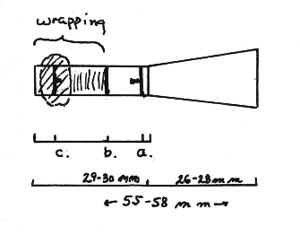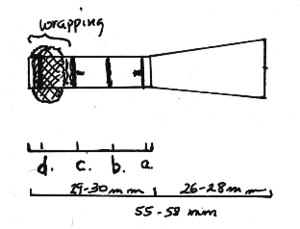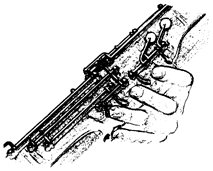| David L. Gibson
Is there one shape, size and/or scrape that would
perform better for all bassoonists? Given all the styles and peculiarities
found to work well for so many fine players, how could there be? Upon this
realization, I find that my approach to the criteria of reedmaking is one
of extreme open mindedness. However, in the never ending quest to arrive
at a set of specifications upon which I could always rely, I keep on
trying new and different directions with my reeds. All the while I am
battling the omnipresent attitude that if and when I do come up with an
answer, it is already common knowledge in our profession.
With the idea of a fourth wire placed on the
bassoon reed, we have yet another avenue to pursue. Is it for a real
purpose or is it just one more wire upon which you could pierce your
fingertip? At least one commercial reed company on the West Coast
professes its usage and refers to it as a "resonance" wire doing
much the same as the second wire (the middle wire on the traditional
three-wire reeds) only to a lesser degree. In my brief trek up this path,
I have met with success in that the tube or bore of the reeds have been
more consistent in shape and that therefore, they "seal" onto
the bocal more satisfactorily. I am not convinced, however, that by simply
adding a fourth wire the reed will obtain more resonance. Perhaps if one
were to advance the procedure a bit, the possibility of added vibrancy
could be increased. For some time now, I have been leaning in the
direction that the less constriction placed on the "active"
portion of the reed the better. We have seen the results of this in the
many single-reed ligatures on the market such as the Winslow, for example.
The question is: which portions of the bassoon reed should be considered
"active"? I am working under the assumption that any increase in
resonance will come from less materials such as string, glue, tape,
plastic, polish, etc. on the "active" portion of the tube. I am
also working under the premise that there needs to be more contrast
between the "active" and the "inactive" portions of
the reed. In order to achieve this distinction, I place the added fourth
wire at the point where the bocal tip begins and wrap with string and
cement up to this new wire only. This is about 9mm up from the bottom of
the reed. I also place the standard third wire under the ball about 2.5mm
up. In comparing this idea to the oboe reed, the staple would be the
"inactive" portion and all cane unrestricted by the staple would
be considered "active." The staple of the oboe reed and the
wrapped portion of the bassoon reed have a primary function of scaling the
reed unit to its respective instrument.
In conclusion, one could say that the major
virtue of the fourth wire is that of being a divider, at which point the
reed becomes clearly separated into two functions: (1) Increasing the
probability of an effective connection onto the instrument, and (2)
Increasing the resonance/ vibration potential of the reed by removal of
all obstructions except the two adjustment wires above the added wire.
Traditional three-wire reed:
a. #1 wire - 1.5mm down from step
b. #2 wire - 9mm down from top wire
c. #3 wire - 4 min up from bottom (underneath turks head)

Experimental four-wire reed:
a. #1 wire - 1.5mm down from step
b. #2 wire - 9mm down from top wire
c. #3 wire - 9mm up from bottom of reed*
(directly over the point where bocal tip begins)
d. #4 wire - 2.5mm up from bottom of reed

* The placement of this wire could vary at least
2mm in either direction and therefore may affect the placement of wire #2
as well.
[David Gibson teaches bassoon at Northeast
Louisiana University, Monroe, Louisiana. Ed.]
|
